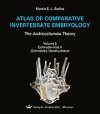![Atlas of Comparative Invertebrate Embryology, Volume 5: Echinodermata II (Echinoidea, Holothuroidea) Atlas of Comparative Invertebrate Embryology, Volume 5: Echinodermata II (Echinoidea, Holothuroidea)]()
Click to have a closer look
About this book
Contents
Customer reviews
Related titles
About this book
The Atlas of Comparative Invertebrate Embryology has two aims. Firstly, it describes embryonic development or ontogeny of several species within a phylum. Secondly, by comparing the different ontogenies this collection supplies a basis for phylogenetic reflections about phylum-level relationships in lower Metazoa. Diversity of ontogenies, embryos and larvae can be an important source for well-founded phylogenetic theories. Like comparative morphology and anatomy, comparative embryology plays a central role for the analysis of evolution.
The Atlas of Comparative Invertebrate Embryology presents a wealth of embryonic and larval developmental processes to emphasize the great variety of ontogenies in the animal kingdom. Like the adult organisms, larvae are also of an enormous diversity owing to the varied requirements of their environment. Within a phylum, embryonic and larval development may be uniform to a large degree, but also deviations are known. In comparing the different ontogenies of an animal phylum, embryologists try to find out the common ancestor and to reconstruct the phylogeny of the group.
Establishing a phylogenetic system of the animal kingdom on the basis of comparative embryology requires a sound theory to integrate far reaching steps in evolution of the animal phyla. Two theories, which are founded in simple events that equally occur in many embryonic developmental courses of different phyla, are the Gastraea–theory of Haeckel (1874) and the Archicoelomata–theory of Masterman (1898). In the Atlas of Comparative Invertebrate Embryology, the phylogenetic system proposed by comparison of the different ontogenies is based on these two theories.
The atlas offers a broad view about the diversity of embryos and larvae and may be useful in looking for a suitable species of special interest. Naturally, an exhaustive description of all ontogenies of animals is impossible. Ontogenies of well known species and detailed research work of their embryos have been chosen. Besides this, embryological research work of some Metazoan phyla is incomplete. Our knowledge of the ontogeny of animals is mainly founded on the classical investigations between 1860 and 1960. In the Atlas of Comparative Invertebrate Embryology, in the chapters concerning phylogenetic interrelationships of phyla, results of studies on morphological or biochemical composition of structures of the adults and of modern gene sequence data may be included into discussion.
Contents
Phylum Echinodermata 7
Class Echinoidea 7
Subclass Cidaroidea 8
O. Cidaroida 8
Eucidaris metularia (LAMARCK) 8
Eucidaris tribuloides (LAMARCK) 9
Eucidaris thouarsi (VALENCIENNES) 10
Prionocidaris baculosa (LAMARCK) 13
Phyllacanthus imperialis (BRANDT) 15
Phyllacanthus parvispinus (LAMARCK) 17
Subclass Euechinoidea 19
O. Echinothurioida 19
Asthenosoma ijimai (YOSHIWARA) 19
O. Diadematoida 21
Diadema setosum (LESKE) 21
O. Temnopleurida 24
Temnopleurus toreumaticus (KLEIN) 24
Toxopneustes pileolus (LAMARCK) 24
Tripneustes gratilla (LINNÉ) 25
Mespilia globulus (AGASSIZ) 26
Holopneustes purpurescens (AGASSIZ) 28
O. Echinoida 31
Echinus esculentus (LINNÉ) 31
Paracentrotus lividus (LAMARCK) 37
Pseudocentrotus depressus (AGASSIZ) 41
Strongylocentrotus pulcherrimus (AGASSIZ) 41
Strongylocentrotus droebachiensis (O. F. MÜLLER) 44
Psammechinus miliaris (GMELIN) 45
Echinometra Mathaei (BLAINVILLE) 49
Echinostrephus moralis (AGASSIZ) 49
Heliocidaris erythrogramma (VALENCIENNES) 50
O. Clypeasteroida 55
Clypeaster humilis (LESKE) 55
Echinocyamus pusillus (O. F. MÜLLER) 56
Laganum depressum (AGASSIZ) 60
Peronella japonica (MORTENSEN) 61
O. Spatangoida 63
Lovenia elongata (GRAY) 63
Brissopsis lyrifera (FORBES) 64
Summary of Embryonic Development in Echinoidea 65
Egg size, cleavage, coelomogenesis, organ formation, and metamorphosis 65
Phylogenetic relationships of the Echinoidea 66
Literature 66
Class Holothuroidea 68
O. Dendrochirotida 69
Cucumaria doliolum (?) 69
Cucumaria planci (BRANDT) 71
Cucumaria glacialis (LJUNGMAN) 72
Cucumaria normani (?) and Cucumaria saxicola (BRADY & ROBERTS) 73
Cucumaria elongata (DÜBEN & KOREN) 74
Phyllophorus urna (GRUBE) 76
Thyone briareus (LESEUR) 76
O. Aspidochirotida 78
Opheodesoma grisea (SEMPER) 78
Holothuria tubulosa (GMELIN) 78
Holothuria impatiens (FORSKAL) 80
Holothuria floridana (POURTALÉS) 81
Holothuria papillifera (HEDING) 83
Stichopus tremulus (GUNNERUS) 83
Stichopus californicus (?) 84
Actinopyga serratidens (PEARSON) 87
O. Apodida 88
Labidoplax buskii (M’INTOSH) 88
Synapta vivipara (ÖRSTED) 91
Synaptula vittata (FORSKAL) 93
Chiridota rotifera (POURTALÉS) 95
Trochodota dunedinensis (PARKER) 96
Rhabdomolgus ruber (KEFERSTEIN) 96
O. Molpadiida 96
Molpadia intermedia (LUDWIG) 96
Summary of Embryonic Development in Holothuroidea 99
Cleavage, gastrulation, and coelomogenesis 99
Indirect development, larvae and metamorphosis 99
Direct development and the doliolaria larva 100
Brooding 100
Phylogenetic relationships of the Holothuroidea 102
Literature 103
Glossary 105
Comparative Embryology and the Archicoelomata Theory 106
Larvae of Archicoelomata 106
Phylum-level relationships and animal superphyla 107
Literature 108
Customer Reviews










































